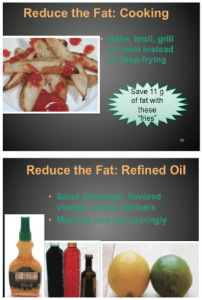Recipe Makeovers
 Do your recipes need a makeover? Read our tips and find out where you can save a significant amount of calories in items you prepare every day.Reduce the fat 4 easy ways:1. Substitute low-fat ingredients for high-fat ones in a recipe. Examples: use broth instead of oil for cooking; choose fat-free half and half in place of cream for sauces; use chicken instead of beef.2. Purchase smarter. Examples: purchase flavored vinegar or lemons instead of high-fat dressings; buy lower fat meats and fat-free dairy items instead of their regular counterparts.3. Cook without fat. Example: instead of deep-fry- ing an item, bake it in the oven. Measure the fat you use when sauteeing instead of free pouring from the oil bottle.4. Trim the excess fat from meat and poultry be- fore cooking.Increase the fiber 3 ways:1. Add more fruits and vegetables to every meal and every dish. Purchase more and keep them on hand for snacks, too. Remember that My- Plate is filled half way with fruits and veggies. You can’t use them and eat them if you don’t have them on hand!2. More beans. Do you prepare dishes with beans at least a couple of times per week? Can you add them in place of some of the meat in fa- vorite recipes? Kidney beans can go in place of some of the ground beef in a recipe.3. Whole grains instead of white grains. Substi- tute a whole grain in place of a refined one. Buy whole grain cereal. Use brown rice. Eat whole wheat bread.Use less sugar1. Buy smarter. Instead of buying sweetened soda, buy tea that is not sweetened. Look for canned and frozen fruits without sugar. Buy ce- real that is not sweetened.2. Substitute fruit. Instead of ice cream, cookies or cake for dessert, serve fresh fruit.3. Omit. When you see a cake or big box of cook- ies, calculate the total number of calories thatyou would be bringing home. A cake that is 300 calories a sliver slice is really 4800 if it serves 16 and if there are only 2 people in the house eating it then you are going to take in a potential 2400 extra calories from eating it al week. Try to omit the sweets from your shopping cart.Reduce the sodium 2 ways1. Purchase more foods that are naturally low in sodium like fruits, vegetables, unprocessed meats/poultry/fish, dried legumes and plain grains like oatmeal, rice and pasta.2. Read the Nutrition Facts Panel to find foods that contain 5% or less of the daily value for sodium. You can really save when you compare!
Do your recipes need a makeover? Read our tips and find out where you can save a significant amount of calories in items you prepare every day.Reduce the fat 4 easy ways:1. Substitute low-fat ingredients for high-fat ones in a recipe. Examples: use broth instead of oil for cooking; choose fat-free half and half in place of cream for sauces; use chicken instead of beef.2. Purchase smarter. Examples: purchase flavored vinegar or lemons instead of high-fat dressings; buy lower fat meats and fat-free dairy items instead of their regular counterparts.3. Cook without fat. Example: instead of deep-fry- ing an item, bake it in the oven. Measure the fat you use when sauteeing instead of free pouring from the oil bottle.4. Trim the excess fat from meat and poultry be- fore cooking.Increase the fiber 3 ways:1. Add more fruits and vegetables to every meal and every dish. Purchase more and keep them on hand for snacks, too. Remember that My- Plate is filled half way with fruits and veggies. You can’t use them and eat them if you don’t have them on hand!2. More beans. Do you prepare dishes with beans at least a couple of times per week? Can you add them in place of some of the meat in fa- vorite recipes? Kidney beans can go in place of some of the ground beef in a recipe.3. Whole grains instead of white grains. Substi- tute a whole grain in place of a refined one. Buy whole grain cereal. Use brown rice. Eat whole wheat bread.Use less sugar1. Buy smarter. Instead of buying sweetened soda, buy tea that is not sweetened. Look for canned and frozen fruits without sugar. Buy ce- real that is not sweetened.2. Substitute fruit. Instead of ice cream, cookies or cake for dessert, serve fresh fruit.3. Omit. When you see a cake or big box of cook- ies, calculate the total number of calories thatyou would be bringing home. A cake that is 300 calories a sliver slice is really 4800 if it serves 16 and if there are only 2 people in the house eating it then you are going to take in a potential 2400 extra calories from eating it al week. Try to omit the sweets from your shopping cart.Reduce the sodium 2 ways1. Purchase more foods that are naturally low in sodium like fruits, vegetables, unprocessed meats/poultry/fish, dried legumes and plain grains like oatmeal, rice and pasta.2. Read the Nutrition Facts Panel to find foods that contain 5% or less of the daily value for sodium. You can really save when you compare!


